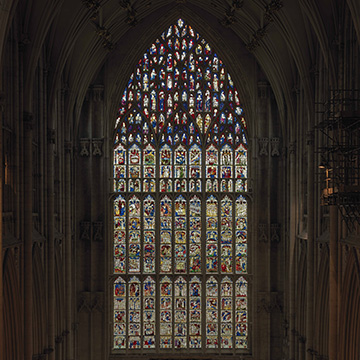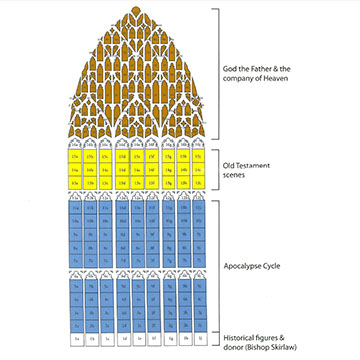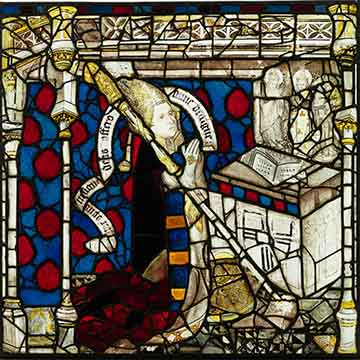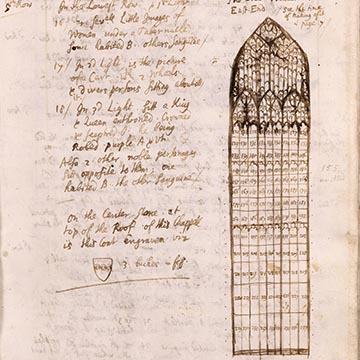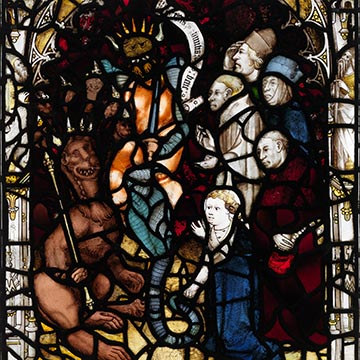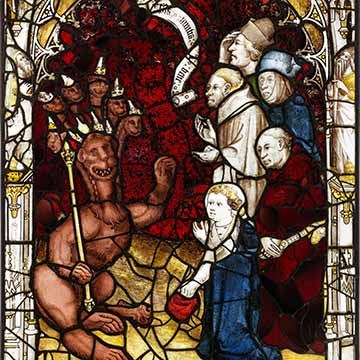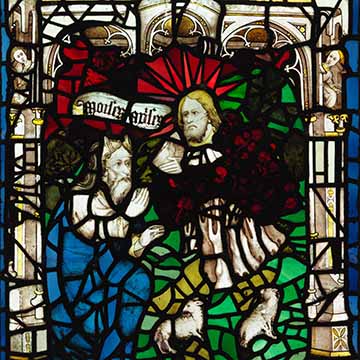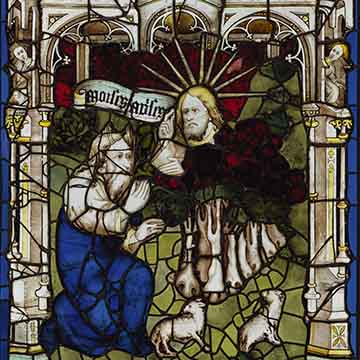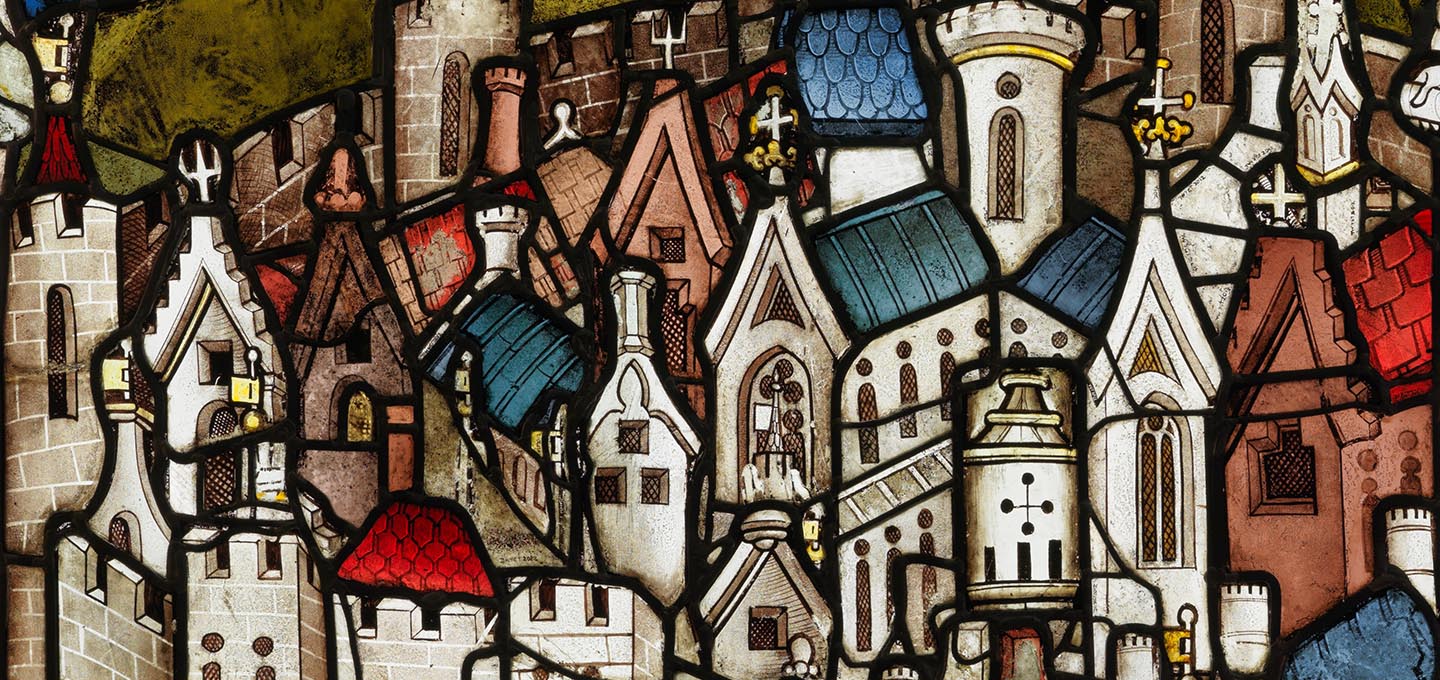
The Great East Window, York Minster, UK
Over 50 Years of Excellence in Stained Glass Craft and Conservation
The conservation of York Minster's Great East window, initiated in 2005 and completed in 2018, was one of the world's largest and most complex conservation projects. This glazing scheme stands as one of the most monumental and significant of medieval artworks, and is the work of celebrated Coventry glazier John Thornton. The window contains two biblical cycles, Creation and Revelation, the beginning and the end of all things. Beneath the heavenly realm at the head of the window, populated by angels, prophets, patriarchs, apostles, saints, and martyrs, there are three rows of 27 Old Testament scenes from the Creation to the death of Absalom. Below this, scenes from the Apocalypse appears, with a row of historical figures at the base of the window. Although a well known subject in medieval art, the selection of Apocalypse iconography in this artistic medium was without national precedent.
Patronage and Execution
Executed in 1405-08, the window is the largest expanse of medieval stained glass in Britain, with over 300 glazed panels, and is one of the most ambitious windows ever to have been made in the Middle Ages. Walter Skirlaw, bishop of Durham (c.1330-1406), has been recognised as the donor of the Great East window. He had been the Chapter of York's preferred choice as archbishop in succession to Alexander Neville (c.1340-1392), archbishop of York (1374-1388), although with the support of King Richard II (1367-1400), Richard Scrope (c.1350-1405) was instead enthroned in 1398. Both Skirlaw's and Scrope's arms appear in the spandrels of the south choir arcade, suggesting that the pair held no animosity and may even have been working in collaboration to bring the eastern arm of the Minster to completion. Neither Scrope or Skirlaw would live to see the completion of the window in 1408, however. In the summer of 1405 Archbishop Scrope led a rebel army against the King, and by June 1405 Scrope was beheaded for his part in the unsuccessful uprising. Skirlaw, by this time an elderly man, died several months later in March 1406. Nevertheless, the complex narratives that the window explores represented a true collaboration of teams of clergy and craftsmen, combining advanced liturgical knowledge with the glass-painters' genius.
John Thornton came to York from the prosperous Midlands city of Coventry. Little is known of his career, but he was presumably a master glazier of some renown when he was awarded the major work at York Minster. Both Skirlaw and Scrope had served as bishops of Coventry and Lichfield and so it is likely that these men were in part responsible for bringing Thornton to York. Both the size and location of Thornton's York workshop is not known, but the glazing contract formed between him and the Chapter at York reveals that he alone was responsible for the design of the window and much of the key painted details. However, analysis of the painting styles shows that there were several glass-painters at work on the window, perhaps necessary in order to deliver this huge project within the three years the contract stipulated. Nonetheless, the Great East window is characterised by the consistently high standard of painting exhibited across the whole window, demonstrating that Thornton selected his collaborators with great discernment and applied strict quality control.
Restoration History
During the seventeenth-century, the window attracted much antiquarian interest from noted authors such as Henry Johnston (d.1723) and James Torre (1649-1699). These accounts are unsurpassed in terms of their material importance, revealing details about the earlier configurations of John Thornton's window that would not have been easily comprehended otherwise, and reproducing Thornton's now lost glazing contract. The documentary record has shown that panels at the base of the window, and those in row 13 (both accessible from stone walkways), had been moved out of their appropriate typological order.
By 1824, the east front's stone was being renewed, during which time the glass was removed and re-leaded. The names of the glaziers had been scratched onto several of the glass pieces, beginning in July 1825. The chronological progression of these glaziers' marks indicates that work to the glazing descended down the window with panels returning to the location in which they had been found. By the 1860s, Britain had experienced a period of rapid industrialisation, and in a pioneering move, the Minster became one of the first buildings in Europe to employ external protective glazing in order to safeguard its windows. The original medieval glazing groove was abandoned and two new grooves were cut into the stone either side of it. Plain glass was fixed into the outer groove, thereby removing the east window from its role as a weather shield. Unhappy with its external appearance, in the subsequent years the secondary glazing was replaced with more traditional diamond quarries.
During the twentieth-century, the east window was again disturbed when industrialised warfare posed a very real threat. At the outbreak of World War Two, aerial bombardment was judged to be a possibility and the Great East window was among 80 windows removed for safekeeping. The re-leading of the tracery of the Great East window was underway by 1943 under the direction of York Minster's new Dean Eric Milner-White (1844-1963). No longer content to re-lead strictly as found, Milner-White was convinced that the windows could be improved upon. The result was the removal of the 1820s coloured glass and other glass identified as not having originally belonged to the window. While this glass was being removed and reordered, other fragments judged to be closer in date, colour and character were substituted in their place. This extensive reconfiguration of the panels had the effect of disrupting the original lead-lines of the panels, and the new leads used were also of an entirely different profile to the original. Some glass pieces now known to have been original to Thornton's window were erroneously removed, and some cut and reshaped to make them fit elsewhere.
In 2005 the east front's stone was again judged to have been in a perilous condition. The York Glaziers Trust had at this stage just completed the conservation of the St William window in the north-east transept, benefitting from an informal advisory committee composed of art and architectural historians, and technical experts. This model was emulated for the Great East window, forming the East Window Advisory Group (EWAG), whose role was to develop and support the work of the conservators. Trial panels were first removed in order to assess the condition of the windows, and an extensive period of research was also embarked upon. During the conservation, panels were dismantled from their non-original wide leads and the glass cleaned and edge-bonded. Through a combination of art historical research and forensic examination of the glass itself, attempts were also made to recover the original cutline of the panels. Further deterioration of the window was ensured through the installation of an appropriate system of ventilated external protective glazing. Ultra-violet filtering glass was used for the secondary glazing so that the light-sensitive conservation materials could be fully protected.
Project Value and Funding:
The total project cost was £11.5m. The conservation work received major funding from the Heritage Lottery Fund, with the support of the York Minster Fund and independent donors.
Awards:
2011 York Guild of Building, Award for Excellence
2015 Radcliffe Trust, Balfour of Burleigh Tercentenary Prize
2018 York Design Awards, John Shannon Conservation Award
Selected Bibliography:
G. Benson, The Ancient Painted Glass Windows in the Minster Churches of the City of York, Yorkshire Philosophical Society Annual Report for 1914, York, 1915
S. Brown, Stained Glass at York Minster, London, 1999
S. Brown, 'Our Magnificent Fabrick', York Minster: An Architectural History 1220-1500, Swindon, 2003
S. Brown, Apocalypse, The Great East Window of York Minster, London, 2014
S. Brown, A Stained Glass Walk Around York Minster, York, 2014 (available to read here)
S. Brown, The Stained Glass Windows of York Minster, York, 2014 (available to read here)
T. French, York Minster: The Great East Window, Oxford, 1995
T. French, York Minster: The St William Window, Oxford, 1999
T. French and D. O'Connor, York Minster: The West Windows of the Nave, Oxford, 1987
E. A. Gee, 'The Painted Glass of All Saints Church, North Street, York', Archaeologia, 52, 1969, pp. 151-202
F. Harrison, The Painted Glass of York, London, 1927
C. Morgan, 'A Life of St Katherine of Alexandria', Journal of the British Archaeological Association, 162, 2009, pp. 146-178
D. O'Connor and J. Haselock, 'The Stained and Painted Glass', in G. E. Aylmer and R. Cant (eds), A History of York Minster, Oxford, 1977, pp. 313-394
J. Rickers, 'Glazier and Illuminator: The Apocalypse Cycle in the East Window of York Minster and its Sources', Journal of Stained Glass, 19 (3), 1994-95, pp. 269-75
Get In Touch
If you would like more information on our conservation services please get in touch.
Contact UsContact Us
The York Glaziers Trust, 6 Deangate, York, YO1 7JB

